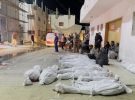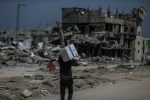GAZA, (PIC)
In Gaza, stories of pain never cease, and the sounds of suffering echo constantly across a region ravaged by nearly a year of genocidal war, while the world watches in silence.
Before the war, the heavy burdens of life and the Israeli blockade, now in its 17th year, had already cast a shadow over the lives of Gaza’s youth, forcing them to navigate a reality full of challenges as they tried to build a better future for themselves and their children. However, those efforts, along with the dreams and ambitions they represented, were buried under the rubble of homes built with much hope.
Mahmoud Safi, 38, was one of those young people known for their ambition and determination. He worked as a police officer in the Palestinian government in Gaza and also engaged in freelance online marketing. A graduate of the Islamic University of Gaza with a degree in Information Technology, Mahmoud was a man of high aspirations.
His father, Shukri Safi, describes him as an outstanding student and an individual whose ambition knew no bounds. After graduating, Mahmoud joined the police force and later started his own online business to improve his financial situation and realize his dream of building a villa.
Mahmoud bought a piece of land in the Austrian Quarter west of Khan Yunis in southern Gaza and began constructing the home he had always dreamed of. “He spent months working on the house, putting his heart into every detail,” his father recalls.
However, when the Israeli army launched a major ground offensive in Khan Yunis on December 5, 2023, the house where Mahmoud and his brother Anas were staying was hit by an airstrike in January, resulting in their deaths.
His wife tearfully recalls the dream they shared, saying, “We moved into the house in 2022, but we never had the chance to enjoy it. It was supposed to be a place for our happiness, but I never imagined my husband would die there.”
She adds that the walls of the house are not as precious as her husband’s life, who left behind two children, Yahya, 8, and Sarah, 2.
Yahya, still unable to speak about the tragedy, remains deeply affected. His mother says that both children miss their father every day and often experience severe emotional distress.
Losing a lifetime
Mahmoud’s friend, Mahmoud Al-Haddad, reflects on the loss: “Mahmoud spent so much time building a good life for his family. None of us ever imagined he would be killed in the very house he invested so much in, planning every detail with care.” He adds, “This is a brutal occupation that destroys life and dreams and commits the worst crimes.”
He understands the profound impact of such a loss, recognizing that losing a spouse and a home in Gaza, where building a house under normal circumstances is an immense challenge, is devastating. “Losing a home means losing years of effort, cherished memories, and the sense of security and refuge.”
Nearly 11 months after the war began, the ongoing genocide in Gaza has claimed the lives of over 40,000 Palestinians, with 24% of them being youth, according to statistics from the Palestinian Central Bureau of Statistics on International Youth Day, observed on August 12 each year.
Projections indicate that Gaza’s population growth rate, which was expected to be around 2.7% in 2023, will likely drop to about 1% by mid-2024.
Additionally, birth and fertility rates are expected to decline significantly as couples avoid having children due to the current conditions, fears for the health of mothers and children, and a sharp decrease in new marriages during the Israeli offensive.
“We won’t have more children”
Asma Al-Gharib, a mother of one who recently celebrated her child’s birthday, shares this sentiment. She and her husband have decided not to have more children for several years.
“We don’t want to bring children into a world where we don’t even have a home to shelter them,” says the 30-year-old mother.
Asma’s apartment in the Rimal neighborhood in central Gaza, which she had personally designed as an architect specializing in interior design, was destroyed by the war. She still keeps the keys to her home as a symbol of her immense loss, a tradition dating back to the mass displacement of Palestinians during the 1948 Nakba.
Most of Gaza’s residents are refugees or descendants of refugees who fled or were expelled from their homes during the 1948 war that accompanied the establishment of the Israeli state on Palestinian land.
Asma explains that losing a home is not just the destruction of a physical structure; it’s the erasure of safety, memories, and hope. “I used to hear my father say that people build their homes with their teeth. I didn’t fully understand this saying,” she reflects.
“But I realized its meaning when I thought about all the sacrifices my husband and I made to build a home that would give us emotional and social comfort, how we gave up so much for it. The saying is profound, as if our teeth rust from not using them.”
She continues, “Homes are more than just buildings; they are sanctuaries filled with family life, even if there are problems within. When a home is destroyed, an entire life experience is lost.”
Distorted demographics
The Palestinian Central Bureau of Statistics predicts that the demographic structure of Gaza will be directly affected by the Israeli military’s targeting of specific population groups, such as children and youth (aged 18-29), who make up 22% of the population. This will lead to a distorted population pyramid, especially at its base.
Furthermore, in the medium to long term, the population’s age structure is expected to be impacted by a significant decrease in birth rates in the coming years, as the young adults who would typically contribute to the population’s growth are being targeted or killed.
The repeated airstrikes and the ongoing blockade have devastated Gaza’s infrastructure and education system, severely limiting opportunities for youth in education and employment. Many have been forced to take on significant responsibilities, having lost family members or homes, and now struggle to earn a living under dire conditions.
Among them is Abir Ahmad, a fashion designer who says she has faced numerous challenges in obtaining basic sewing tools like scissors, measuring tapes, threads, buttons, and suitable fabrics, in addition to frequent power outages that disrupt her work.
Abir adds that she constantly searches through markets, such as the Deir market, to find the additional fabrics and sewing tools needed to meet the clothing needs of children.
Despite these challenges, Abir remains determined to continue her efforts from within a tent in Khan Yunis.
International organizations report that 70% of residential buildings, businesses, and hospitals in Gaza have been destroyed or severely damaged.
According to the American agency Bloomberg, most of the rubble consists of destroyed homes. In Khan Yunis alone, at least 8.5 million tons of debris will need to be cleared. In Gaza City, located in the northern part of the Strip, the destruction accounts for more than half of the region’s total rubble.
The United Nations Environment Program’s assessment, published in July, indicated that 137,297 buildings in Gaza, more than half of the total, were damaged. Of these, over a quarter were completely destroyed, about a tenth suffered severe damage, and a third sustained moderate damage.















